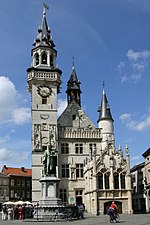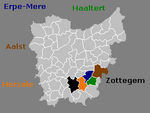Saint-Joseph Church (Aalst)
Aalst, BelgiumBelgian pipe organ buildersGothic architecture in BelgiumInfobox religious building with unknown affiliationRoman Catholic churches in Belgium

The Saint-Joseph Church (Dutch: Sint-Jozefkerk) is a neo-Gothic church with basilical construction, located in the Belgian city of Aalst (province of East Flanders). Work on the church started in 1868 and was completed in 1908. The future of the church is currently uncertain due to serious stability problems however in 2023 it was decided to restore the building. It is the tallest building in the city of Aalst (91 m). The restoration will cost 36 million euros and will get subsidisation from the Flemish government.
Excerpt from the Wikipedia article Saint-Joseph Church (Aalst) (License: CC BY-SA 3.0, Authors, Images).Saint-Joseph Church (Aalst)
Esplanadeplein,
Geographical coordinates (GPS) Address Nearby Places Show on map
Geographical coordinates (GPS)
| Latitude | Longitude |
|---|---|
| N 50.9411 ° | E 4.0352 ° |
Address
Sint-Jozefkerk
Esplanadeplein 4C
9300 (Aalst)
East Flanders, Belgium
Open on Google Maps










